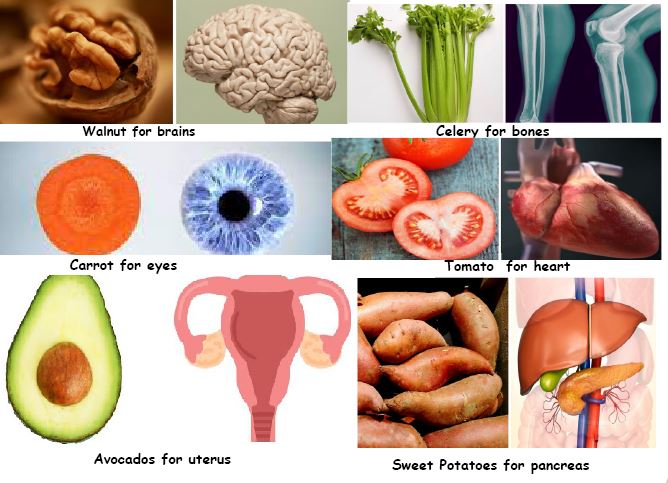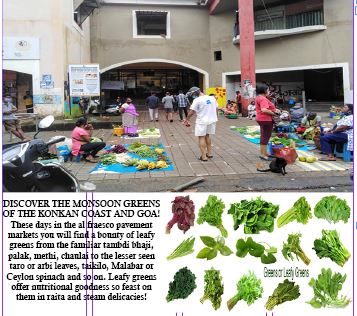DISCOVER THE MONSOON GREENS OF THE KONKAN COAST AND GOA! These days in the al fraesco pavement markets you will find a bounty of leafy greens from the familiar tambdi bhaji, palak, methi, chaulai to the lesser seen taro or arbi leaves, taikilo, Malabar or Ceylon spinach and so on. Leafy greens offer nutritional goodness so feast on them in raita and steam delicacies!
By Tara Narayan
COME the monsoon and it’s difficult not to feast of greens which the veggie greens offer in the local Konkan market place! Some say don’t eat greens monsoon months but I say eat them, different leafy green daily. Amongst the leafy greens I love dill greens the most and seeing a luscious small bunch at the Panaji morning pavement last week I asked one of the snootier vendors how much? She looked away and said Rs50, knowing full well that this madam is not going to buy it for that rate! Usually I also ask if she will give me half bunch for half price and needless to say some vendors refuse and some agree, depending on their state of mind. I buy in small quantities because mine is just a family of two seniors and what’s the point of buying in large bunches, especially when it comes greens which rot up very fast.
Anyway, I didn’t get my dill greens that day. Dill greens are my all-time favourite greens and I love to chop them up and do dilll-tossed potato salad or do dill in raita or veggie pulao…just about anything, drop them in a mild buttermilk khadi (never dal) almost like a soup…or in paratha dough. Dill greens are exquisitely lovely and look like ferns. I remember my mother used to love to put chopped dill greens in her steamed “muthia” (savoury dumplings) and there was a dill greens sabzi in combo with moong dal; most folk do like to combine greens with one or other of lentils or beans for protein values. Did you know that a bowl of lentils is worth its weight in good protein (more than say two eggs for breakfast), so don’t knock vegetarian proteins!
What are dill greens? The greens of the dill plant and I dare say they are the most delicate of our greens. Gripes dill water you must know is given to babies to treat colic, I rather like the taste of dill water! Dill is hard to find though and possibly the most expensive of the leafy greens. Most leafy greens with pavement vendors are Rs20-25-30 per bunch. Spinach or palak is well cultivated as is fenugreek or methi greens, and of ofcourse with the other seasonal greens in the market the most common tamdi bhaji or red amaranth takes second place…for Goan leafy greens connoisseurs want to relish such greens as wild taikilo greens and kuduchi greens…also the crescent-shaped green peels of “goddavlim” or the caju tree cotyledons which are monsoon delicacies like wild mushrooms and ambade oval and round, etcetera.
ANYWAY, this is to say the monsoon season is the season of greens and most everyone doing a Goan kitchen may be seen serving other greens apart from the more or daily fare of red amaranth or tamdi bhaji …such wild greens as the now favourite taikilo or kudikechi bhaji . Wild taikilo in Konkani is cassia or takla tora English, Ayurveda says the leaves have medicinal properties. Only the taikilo leaves are used to do light stir fries and if you’re asking me all greens have medicinal values – which come through depending on how you cook them, smothered in masala or in light cooking before stirring in a raita or salad mix.
Greens lend themselves very well in a raita – just steam cook them lightly and stir into a natural or seasoned or tempered slightly tart curd or yogurt. These monsoon days of July I find the idea is to go for a trek in some wilderness place in Goa’s countryside and pick up a variety of wild greens…for free! You will also find the heart-shaped taro leaves peeping up here and there and these may come green stemmed purplish stems – the baby ones are fine for steam cooking into a “muthia” of sorts, that is you wash, wipe dry, paste with a spiced up gram flour batter with tamarind in it, ajwain/sesame seeds tossed in…layer the leaves, roll and steam cook. It’s a fast cook. Remove rolls, cut into wedges and serve smeared with ghani-pressed sesame seed oil or ghee or you may do the usual tempering and garnish with freshly chopped green coriander leaves, serve, enjoy on a rainy day tea-time rest and recreation time. Taro leaves are also called arbi leaves.
Monsoon time is to discover and adventure with green amaranth or kuddukechi bhaji, also the glossy-leaved Malabar spinach, fenugreek or methi greens are popular, palak or spinach of course, but count yourself if you find bathua or sour spinach greens…drumstick/sahjan/moringa leaves are rated very highly. The sour greens of ambade are very desirable but rare to find (also called gongura in Telugu in Andhra Pradesh where a gongura leaf pickle is famous; in Marathi it is ambadi, in English the roselle plant or red sorrel leaves, there is both red and green ambade).
Altogether these leafy greens are loaded with the goodness of soluble and insoluble fibre, they are iron and folic acid rich, sarson da saag is rich in glucosinolates but the Punjabi-styled sabzi is a heavyweight affair drowned in ghee or oil, magnesium, phosphorous, etcetera. All leafy greens if you’re asking me are anti-carcinogenic. Eat them daily uncooked, cooked and never overcooked! A lot of goodness is lost when we generously load them with spices, salts, sugars and pop them in the micro oven where all food turns to dead food, no matter how much our spoilt taste buds approve of it!
IF YOU seek fighting fit sustainable health keep it simple and as primary as you can. In this I suggest you read up all the health columns of Dr Deepak Chopra or Dr Shiva Ayyadurai, I dare say they’re the two most famous American Indians in the US of A; while the first has built a fortune to retire on clueing up Americans on how to define health (yes, meditation does lower levels of stress hormone like adrenaline driving your blood and because he practices what he teaches, presumably he is in his very cool as cucumber fighting fit in his mid-70s, reportedly he’s never never been sick. E-mail inventor and MIT PhD four times over Dr Shiva Ayyadurai is undoubtedly a firebrand stormy petral in American politics and is fighting the presidential elections coming up in 2024 – needless to say if he wins he will be making history as a naturalized American born in Mumbai that was Bombay! Ayyadurai wears many feathers in his cap and comes across someone who plays clean politics vis-à-vis the appallingly degenerate political scenario in USA…the question is, will American voters be intelligent enough to see through all the dirt he is exposing and vote for him? It’s left to be seen.
DOCTRINE OF SIGNATURES!

DR SHIVA Ayyadurai is a scientist first and his take on the modern immune system is worth reading up, including his video health series talks. You must look them up on one of his TruthFreedomHealth.com online sites. Recently, I found him talking of how strawberries which look like the heart are actually good for the heart. Please eat strawberries if you have a heart problem!
You may or may not know that right from the 1500s there’s been some divine scientific wisdom called Doctrine of Signatures or similarities in nature versus bodily parts – like if a strawberry looks like your heart it’s good for your heart. Likewise, red tomatoes are good for blood vitality, that’s also heart health! Again if a cut carrot slice looks like the eye, it’s good for eyes…carotene rich and therefore vitamin A rich, eat a carrot a day. Why eat tomatoes – because they cut open to reveal four chambers just like the human heart, etcetera, etcetera, you get the gist of this.
I mean ancient wisdom has defined nutritional wisdom and it makes sense if you’re asking me! Did a bit of homework and came up with all this, make a note: Somewhere in the Bible, “God has marked everything he created with a sign (signature) and the sign shows the purpose for the creation of the item.” Other veggies shaped like body parts: walnuts are good for the brain (enough DHA that is omega 3 fatty acids, will boost and regenerate your brains if they’re still alive); eat mushrooms for good ears; sweet potatoes for pancreatic health; ginger for stomach woozies; celery for bones; grapes for alveoli and lung health (grapes are also for asthma, emphysema, lung cancer protection)…avocado for uterus; red wine is full of antioxidants and polyphenols and vitalizes blood, makes it thinner, not so viscous (you know the dangers of thick viscous blood don’t you)…
And this bit made me smile! Cut more onions to eat for if it makes you cry — it is because the epithelial layer of cells of your eyes are getting a washing they’re desperately in need of! Onions look like the trillions of cells which make up body beautiful or something like that. It’s fascinating, nah? What else?
These days I’m looking high and low for the fruit of the chayote squash or chow chow (of the gourd family, Cucurbitaceae), it’s the mother of all vitamin C and we need vitamin C on a daily basis, it’s the speed-up-healing vitamin…and did you know celery is rich in vitamin K (who’s heard of vitamin K?) and calcium which is good for strength and regeneration of tissues? Again, from all research, celery is rich in sodium and bones are 22% sodium! Ever heard that celery may replace salt in your salads?
I’m certainly going to buy celery from now onwards, celery, parsley, tomatoes (even if they’re Rs130 kilo in Panaji market even if not the organically cultivated version and may have tons of pesticide in skin, buy organic tomatoes if you can!), and of course chayote and chow chow – why can’t I find it in the Panaji market!’ If you know where I may find them, please let me know.
Go look up the Doctrine of Signatures, my friends and learn to eat from farm to table more and more if you want to live happily and stretch your happiness out till doomsday is inevitable at 100 years or plus, plus bonus years! If you’re happy, you want to live on, if unhappy, I guess we will forever be seeking the sweet balm of death!
